There’s a regular column you’ll find elsewhere on this website, called The One That Got Away. It in, the likes of Paddy Hopkirk, Mike Brewer, Steve Parrish, Paul Cowland and many others share the heartache that comes from letting a car or motorcycle you hold dear slip out of your life. I recognise the feeling, because for a year, I ran the most exciting car sold in 1986 – the Ford Sierra Cosworth – and then had to give the keys back to the nice people at Ford, never to see it again. Or at least, that’s what I thought for 31 years, before the Cossie came back into my life.
My Cossie is the car to which I have a stronger emotional attachment than any I have ever owned. Known simply as ‘D990’, ‘The Cossie’, or sometimes a few other things depending on how it’s behaving, we go back 35 years to the day I clapped eyes on Ford’s fastest Sierra when it was brand new.

D990 PVW had amassed 1,128 running in miles at the hands of the Ford Press Garage team when it was delivered. I was editor of the magazine Performance Car at the time and the hot Sierra would be my long-term test car for the next 12 months. When D990 eventually returned to Ford, I thought I’d never see it again, given that I discovered many years later via the DVLA website that it had been exported, and many early road-going Cossies found their way into motorsport and didn’t survive. And then in 2017, something remarkable happened, but we’ll get to that in a minute. First of all, what exactly is the Ford Sierra RS Cosworth?
The 1980s was the decade of homologation specials. These were the special production cars that were built in limited numbers and sold to us, the general car-buying public, to qualify the car for eligibility to various classes of racing or rallying. Group A was one of the most fiercely fought and Group A Touring Car racing the place for car manufacturers to strut their stuff. The Ford Sierra Cosworth was arguably the greatest Group A Touring Car of its era, developed by a relatively small team of ace engineers at Ford Special Vehicle Engineering at Dunton in Essex.
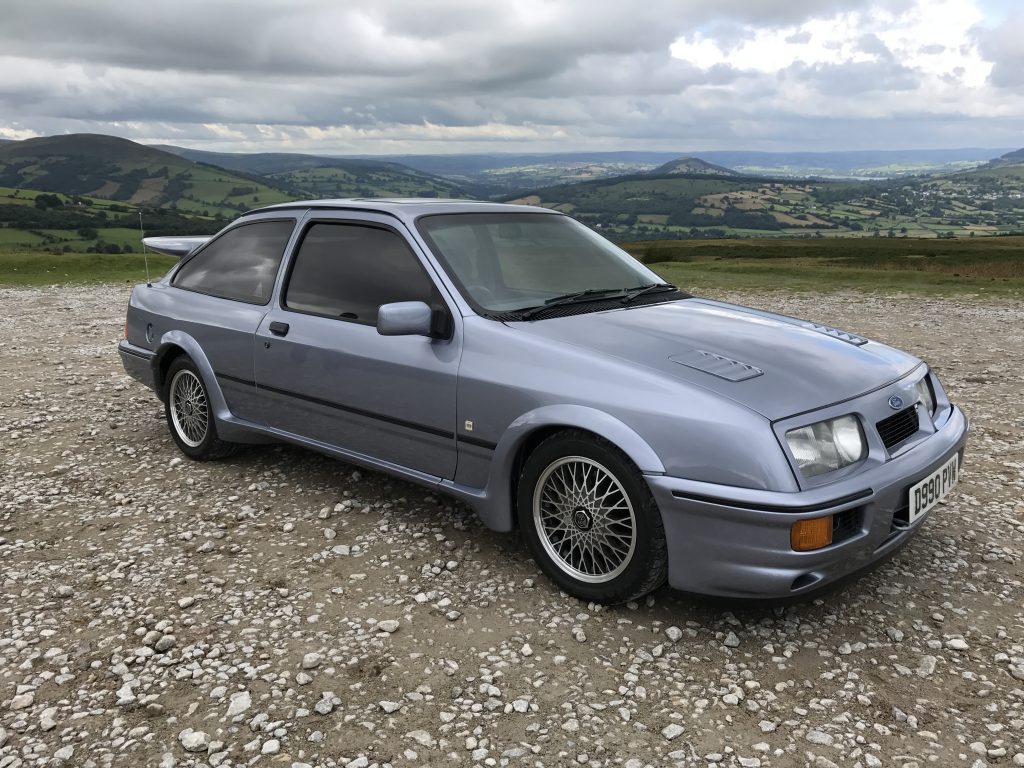
To be eligible for Group A, a manufacturer had to sell 5,000 road-going examples of a car. In very simple terms, the homologation rules forbade the ‘adding of metal’ in key areas, so it wasn’t allowed for example, to fit a bigger turbo to race cars to gain more power. The suspension layout had to be the same too, and any bits required to make the car competitive on track had to be ‘homologated’ on a road going production car. Hence the term ‘homologation special,’ a production car but one which went on sale with special modifications needed for racing. Manufacturers were also allowed to produce a further limited run of 500 ‘evolution’ cars. This would be the Ford Sierra RS500 Cosworth with yet more modifications allowing it to produce even more power in race trim.
At 150mph and with a 0-60mph time of 6.5 seconds, the road-going Sierra RS Cosworth would be Ford’s fastest production road car at the time. It had an engine based on Ford’s 2-litre, four-cylinder Pinto block used in cooking Sierras, fitted with a 16-valve head and turbocharger. Unsolicited, Cosworth Engineering had developed a naturally aspirated version of the engine with Ford motorsport in mind but when Stuart Turner, director of motorsports, Ford Europe, spotted it at Cosworth during a visit, he asked if the engine could be turbocharged. This was the early days of turbocharging and lag was significant on most turbo cars. However, Ford and Cosworth cleverly matched the turbo system to the engine, taking full advantage of the fact that software in the latest engine electronic control units could be crafted to get the desired results. The boost pressure was a relatively low 8psi in road trim and the size of the Garret AiResearch T3 turbocharger was modest, reducing the time it takes to respond to the commands of the driver’s right foot. It also produced a minimum of 80 percent maximum torque between 2,300rpm and 6,500rpm and it was this that would give the driver a feeling of endless acceleration.
The Sierra RS Cosworth was also designed as a marketing boost for the mainstream Sierra and as such Ford was keen to get it right, so a small group of journalist, including yours truly, joined a group of the Sierra Cosworth’s key development engineers in Southern Spain in December 1985. Our mission was to drive pre-production prototypes – all painted in Ford Diamond White, and wearing ‘C’-registration plates – and give some feedback.
What greeted us took our collective breath away. The body kit pulled no punches, with wide arches curiously dwarfing the 15-inch alloy wheels because in fact, they were designed to cover much wider and larger diameter racing rims. The huge spoiler produces 20kg downforce at 70mph to counteract the substantial lift the body shape produced at top speed, a top speed the base Sierra had never been intended to achieve or been tested at. The rest, as they say, is history. Former SVE boss, Rod Mansfield summed up the Group A Sierra Cosworth’s racing career rather well when we met up more than two decades later. “Even before it was built,” he said, “the aim was for it to be the European Touring Car Challenge champion, and it was.”
Friends reunited: How my Ford Sierra Cosworth came back into my life
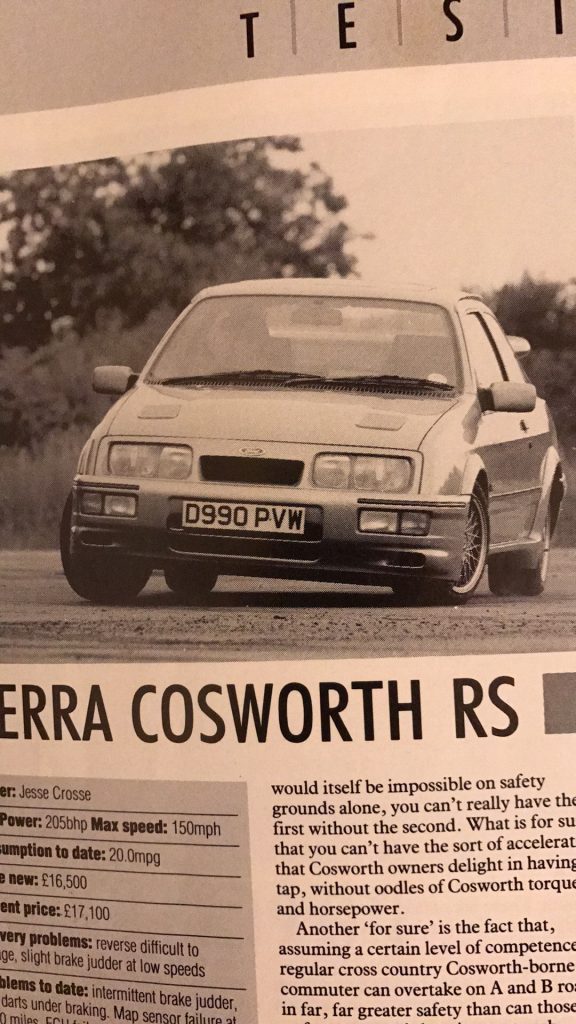
While chatting to Leon Cerri, a Ford RS enthusiast, in 2016, I jokingly said if he ever came across D990 again I’d like to hear about it. I was quite sure I never would, but to my amazement some pictures landed in my inbox a few months later and there it was, alive, looking shiny and in a UK driveway. The current owner bought D990 while living down-under, had recently imported it back to the UK and now it was up for sale.
Being confronted by ‘my Cossie’ in the flesh after 30 years for an Octane magazine shoot a few weeks later, triggered some unexpected emotions and within a month I’d done the deal and was heading home with D990 on a trailer. Back in the day, I’d covered 22,965 miles in it and was looking forward to the next innings.
So what happened to it while we’d been parted? Well, in September 1986 when my long-term test was over, the car went back to Ford and was sold to Brodie Brittain Racing, an early specialist in tuning and ‘chipping’ the turbocharged Ford Cosworth engines to release more power. It was later sold to a private owner who in 1992 emigrated to Australia and took the car with him. During the intervening years it underwent some restoration at SCS Motorsport in Queensland and the engine was rebuilt with high performance parts and a larger turbo which according to dyno figures in the history file, yielded 300bhp.
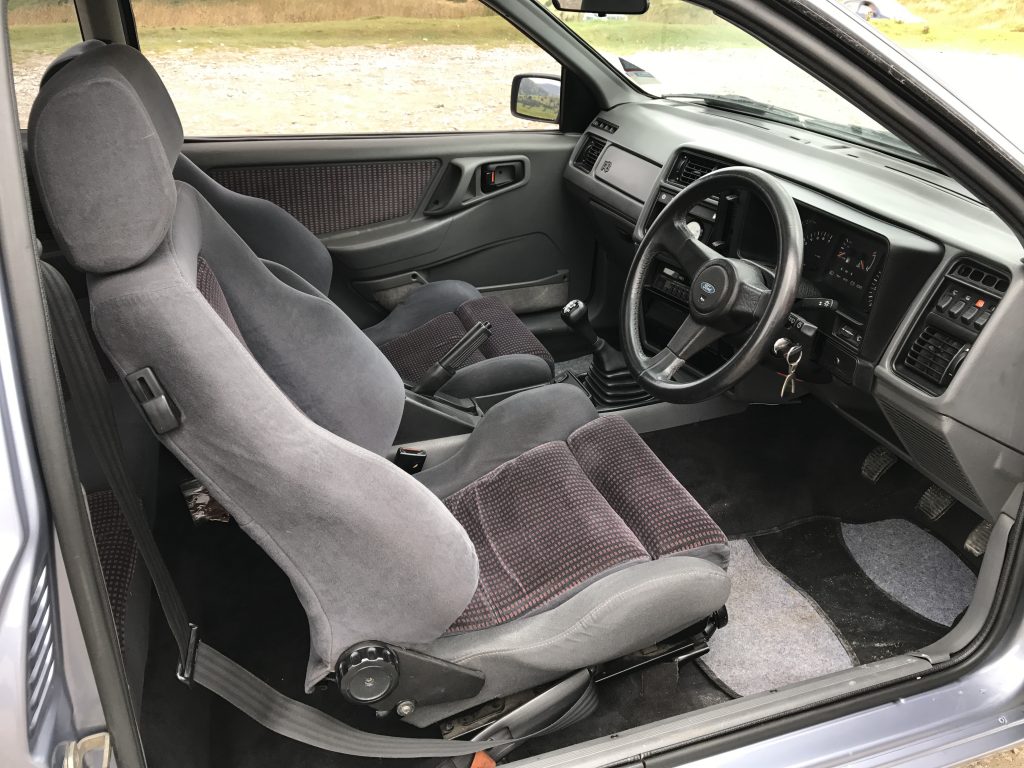
Fairly typically, it had lowered suspension and stiffer springs, a noisy big-bore stainless steel exhaust and non-standard drilled rear disc brakes. Under the bonnet the air box had been replaced with a K&N filter and other parts like the plastic radiator header tank and cam belt cover (which like the air box, are unique to the 3-door Cosworth) had been replaced with aftermarket alloy alternatives, and a huge intercooler replaced the smaller original. Another rare detail like the electronically controlled Amal valve, which silently releases boost pressure from the air intake system into the airbox when the throttle is closed, were also missing. This had been replaced by the usual ‘dump’ valve favoured on modified turbo engines, which literally dumps the pressure into the atmosphere with a loud ‘psshh’ when the driver lifts off the accelerator.
Thankfully, the interior was mostly untouched, complete with the original Recaro seats and carpets, but the gear lever had been shortened, two fancy white gauges replaced the original digital clock and the dashboard was from the later ‘main stream’ Sapphire Cosworth. The original 3-door Sierra Cosworth dash had an inset speaker grille and the opening would crack badly from the corners. For that reason, many 3-door dashboards have been replaced with the later, grille-free version, which is otherwise identical.
Outside, the fog lights, again unique to the 3-door Sierra Cosworth due to the large moulded front bumper and spoiler, had been replaced by RS500-style grilles. The car had been resprayed but was nice and shiny and importantly, the right shade of its original Moonstone Blue. It also had the original 3-door Sierra Cosworth wheels clad with Bridgestone tyres. The original Dunlop D4s developed especially for it were discontinued many moons ago.
Verifying whether the Cossie was my Cossie
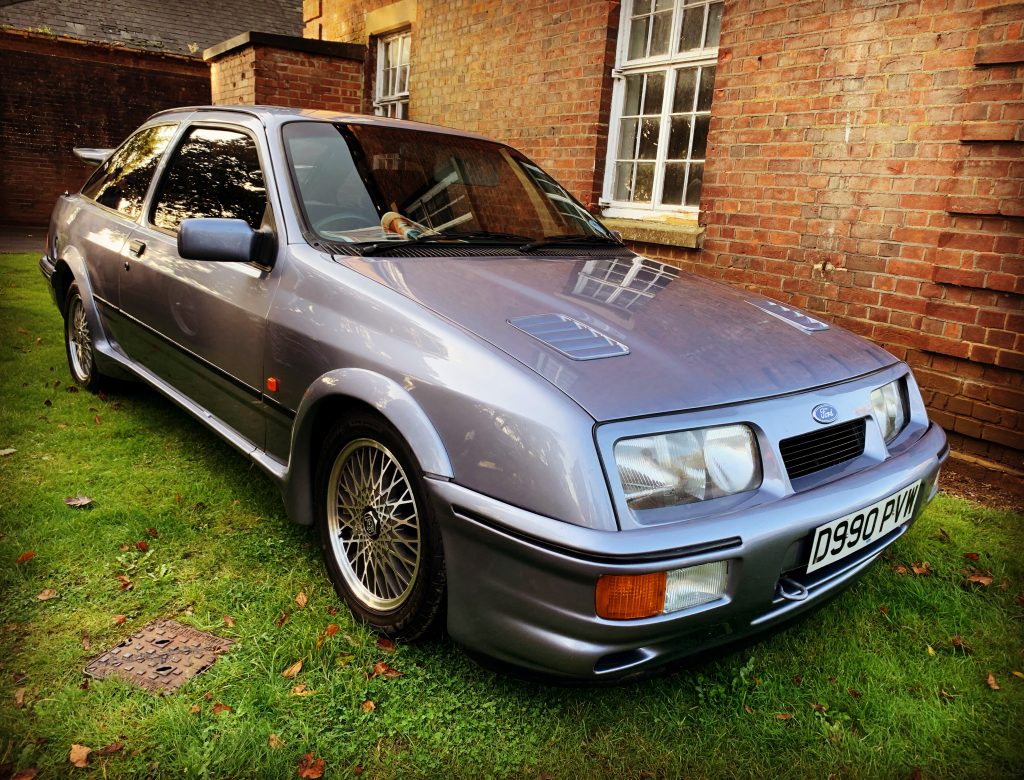
I hadn’t been planning to buy a Sierra Cosworth again but meeting up with my old flame had changed things. This was the very car I lived with all those years ago, and far as I know, it’s the last surviving Ford UK Sierra RS Cosworth that was run as a press car. And it goes without saying, the Sierra Cosworth is a special car in its own right, and having played my own small part in its history during its development and driving the early prototype cars, as well as reporting extensively on the car once it landed in Ford showrooms, with countless road tests and group tests of the winged wonder, there was as much an emotional connection as a professional one.
However, before I got carried away with shaking hands on a deal, first there was the business of verifying whether it was, indeed, ‘my’ Cosworth.
Press cars in the automotive industry are new models owned and run by the manufacturer and usually maintained in the company’s own workshop dedicated to that task (the ‘press garage’). When duties as test cars for the media are over, they’re sold off. A press car isn’t a random car that has appeared in a magazine or an advert as some are claimed to be. Ford’s press cars were registered in Essex and the fleet of 10 1985 white prototype cars all carried registration numbers ending ‘HVW’, while the 1986 production cars all wore ‘PVW’ like this one. Paul Wilson, who worked in the press garage at the time, confirmed there were 10 ‘PVW’ plated Sierra RS Cosworths in the press fleet, a convenient number when it came to running the cars in because there were exactly 10 members of the Ford press garage team at the time.
In the history file, there’s a copy of D990’s second V5 listing Brodie Brittain Racing as the owner and Ford Motor Company as the first owner. I checked the all-important VIN number stamped in the driver side floor to make sure it’s genuine. I also checked for something a mate in the trade alerted me to as a favourite method of ‘ringing’ Sierra Cosworths back in the day, that the entire floor panel hadn’t been cut out and welded into a different shell. I needn’t have worried, the floor was perfect, and like the rest of the car, rust free and with a shiny underside to match the top.
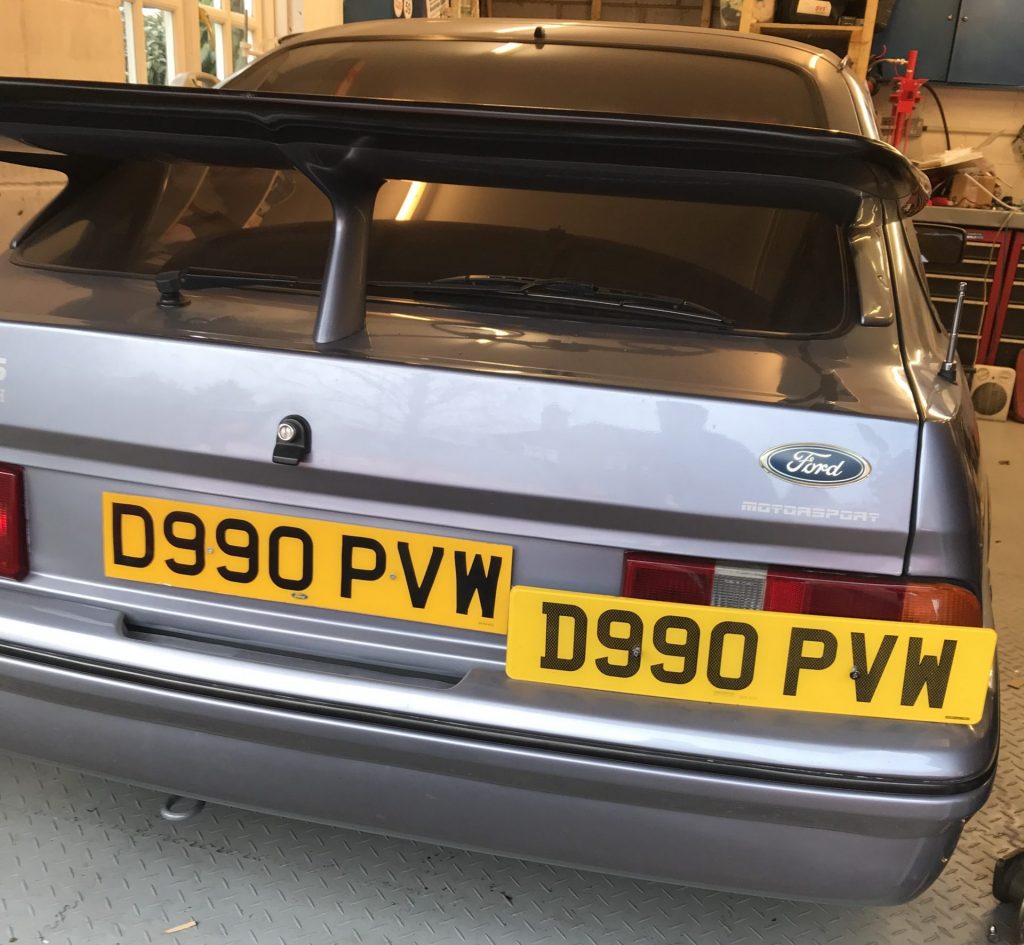
Further confirmation, if any were needed, came from an unexpected source. After the feature appeared in the magazine, the third owner who had exported the car to Australia in 1992 got in touch. He subscribed to Octane, had read the story and was excited to see his old car. Attached to the email was a photo of the original UK plates fitted by the Ford press garage, adorning his garage wall. In 1986, UK registration plates weren’t plastic as they are today, but cut from a sheet of aluminium, covered with yellow film and of course, the registration number.
Unlike regular plates, they didn’t carry a dealer name and address, just the blue Ford Oval, the usual practice for the Ford Press Garage. Crucially, the typeface was different then and gives any car of that period quite a different look from the chunkier font used today. I asked if he would consider selling the plates to me but the reply was they weren’t for sale. Instead, he would send them to me free of charge so they could be reunited to the car. The final confirmation that this D990 PVW was the real thing came when they arrived and I offered them up. The mounting holes in D990’s bumpers matched those in the plates.
What next?
When I took back custodianship of the car I was busy with another restoration, so my aim is to steadily re-commission and restore D990 over a period of time.
The original road car had a decent ride and was quiet to the point of blandness when pottering around, much like a base Sierra. But then the horns would come out when you hit the gas pedal, with surprisingly little turbo lag and that strong low-down punch which seems to go on and on. As it stood, the stainless steel big-bore exhaust was noisy with unpleasant resonances, the ride was harsh and the engine suffered from excessive turbo lag due to the larger turbo and re-mapped engine management software.
The obvious thing to do, then, was return the Cossie to the car I once knew. I’ll tell you about how I went about that in the coming months.
For now, if you have have ever wondered what fate might have befallen one of your old cars, take it from me that it’s never too late to start searching. Begin by using the government’s MOT history tool to see if it’s still registered for the road, then contact owners’ clubs, or use forums and social media to summon the power of the community to help you on your quest. Who knows, you might just end up reunited with an old friend.
Read more
I bought a Lotus Esprit – and broke every car-buying rule in the book
The Volvo Duett that was rescued from wildfire hell
Restoring a Lotus Elan kept me sane during lockdown



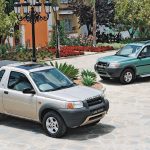





Loved the cossie story I feel exactly the same as you. I have a sierra sapphire in white totally original never been painted it is chipped up but I have the original chip and waste gate to put back and big stainless exhaust could go back to original had it for 30 years will pass on to grandson when I am gone
Not in the same league, but I’ve just got back my second generation (P38) Range Rover, after 6 years with another owner. Definitely a ‘heart’ rather than ‘head’ purchase… and when I say that a new battery cost nearly as much as I paid for the whole car, things get into perspective. But the £3.51 in loose change I found in the door pockets and down the back of the seats, actually make it even more of a bargain!
I remember attending car auctions in the 80s when written off Sierra Cosworths were being sold for ridiculously high prices considering their condition. It soon became clear the wrecks were being bought for their all important vin number stamped floor pan as mentioned in the article and the sales were stopped.
Delighted to read this information.
I bought a white Sierra in Perth in 2016. The ex owner was an elderly man from the uk who told me the car was a press car, and gave me the information and the magazines about the car
D767PVW. I’ve all the MOT back as far as 1990.
I’m trying to regain as much information as I can
Thanks for putting up the article